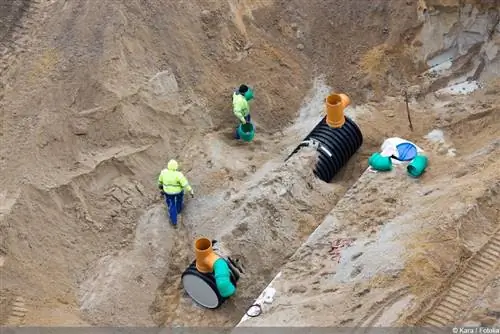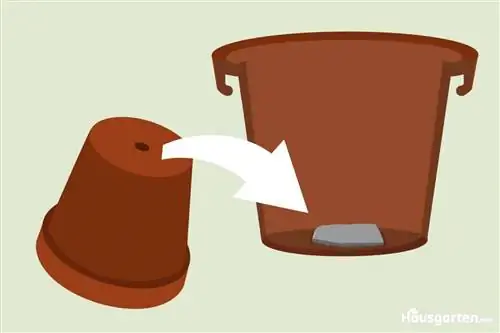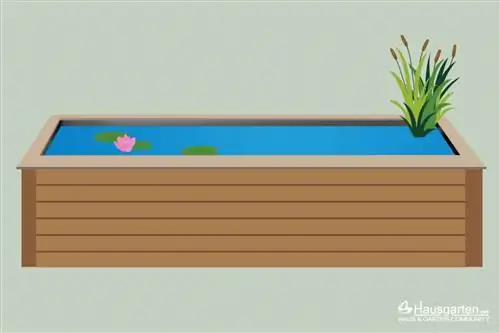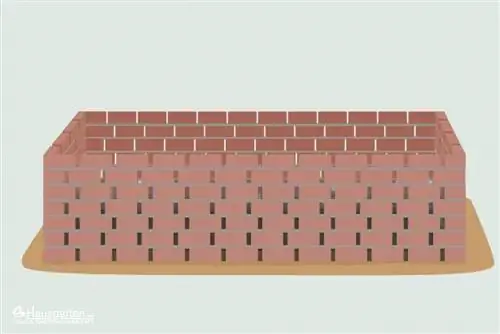- Author admin [email protected].
- Public 2023-12-17 03:39.
- Last modified 2025-06-01 06:48.
If you want to create a septic tank yourself, you have to pay attention to various factors. Comprehensive construction instructions alone are not enough. The permits for the pit and the appropriate size of the excavation must also be taken into account. In order to save costs and find a working solution for rainwater and wastewater, appropriate planning must be carried out in advance.
Function
The function of septic tanks is traditionally to remove wastewater and excrement. Soak pits can be found under pit toilets, for example. Here, urine and other liquids can seep into the ground, while solid substances are retained and rot in the pit. This makes sense, for example, if connecting to the sewage system is not possible or involves a very high financial outlay.
However, this type of use is only very rarely permitted in Germany. Collection pits are now usually used instead. Nothing seeps into these as the walls and floor are impermeable to liquids. If the collection pit is full, it must be pumped out. In terms of wastewater treatment and environmental protection, this makes much more sense than allowing wastewater and excrement to seep into the ground. However, this involves additional effort and follow-up costs, so it must be considered whether a connection to the sewage system might not be a more financially advantageous choice in the long term and requires less effort.
Approval
Seepage pits are only permitted in Germany to collect and seep away rainwater. Only in very few exceptional cases are they used for outhouses and the like and are approved accordingly. Rainwater seepage pits are also generally only used and approved as temporary solutions.
They fulfill quite useful functions. This includes, among other things, the targeted drainage and seepage of water that would otherwise be dammed up on sealed and built-up areas or seep away in undesirable places. They also relieve the strain on the sewerage system and return precipitation, such as rain or melted snow, directly to the groundwater.
In any case, a permit is required to create one or more septic tanks on a property. This approval can be applied for at the relevant state environmental office. The application should be made before the construction plan takes shape. This saves time and effort and prevents planning from being unnecessary or carried out incorrectly if only a certain type of septic tank is permitted.
Seepage or collection pit?
Precipitation, such as rain, melted snow or hail, can be directed into a pit to seep away - but it can also be used. For example, for targeted watering of the garden or for watering in general or as water for flushing the toilet. Even with this use, the sewage system is polluted less or more evenly, the water is also used for a good purpose and in the long term it can even save money. It is important that the water is channeled into a collecting pit and therefore cannot seep away.
This consideration should also be taken into account when planning.
Construction instructions - step by step
Once the construction of a pit has been approved, everything can happen quite quickly. Because the construction instructions and implementation are not difficult. In fact, only a few steps are required to create the pit and then even be able to access the area above it.
The procedure is as follows:
1. A hole is dug at the desired location. This should be positioned so that the water can seep away easily. The soil should therefore be very absorbent. The excavation can be carried out generously so that the water has enough space to seep away slowly, even in rainy times. The size of the pit cover serves as a guide, which must later fit into the pit and rest on the edge and on the gravel.
2. The bottom of the pit is filled with gravel to a height of about 20 centimeters. This layer is important to keep the soil absorbent and serves as the foundation of the pit.
3. A connection for the rain pipe is inserted at the edge of the pit. This allows the water to be introduced in a targeted manner.
4. In the fourth step, the cover of the pit is inserted or put on. The lid should rest on the gravel and be as straight as possible. This achieves a more even distribution of pressure on the lid. It is also important that the connection or pipe for the rainwater to flow in fits and seals well. In this way the water can slowly enter and seep away or be collected. The lid forms the pit and prevents it from becoming clogged with soil, leaves or other substances.
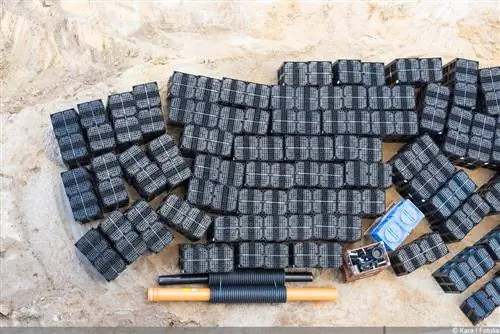
5. After the lid has been inserted, it can be additionally covered with foil. This is not necessary - but it offers additional security and can extend the life of the lid, thus saving costs and reducing future effort.
6. Finally, the excavated soil is piled back over the lid and carefully tamped down. If the area above the pit is not only to be accessible but also accessible, special precautions must be taken here.
The last step is the connection to the pipe system, which drains the water and thus directs it into the pit.
Tip:
It is usually worth using a mini excavator to dig the pit. This also applies if a seepage shaft is created instead of the septic tank - as the diameter and depth should generally be over one meter.
What is allowed and what is forbidden?
This question can only be answered in general terms to a limited extent, as various factors must be taken into account. If you want to create a septic tank, you should first contact the responsible office for information and, if necessary, get advice. It is generally forbidden to create collection or seepage pits without a permit, as well as pits for the purification or infiltration of wastewater, such as pits under pit toilets. Drainless basins may be used here, which can be emptied if necessary and the substances they contain can be disposed of accordingly.
This applies to land that is considered property as well as to leased allotments and other rented areas. Anyone who does not comply with the bans or allows wastewater and excrement to seep away or treat it without permission must expect severe fines. Several thousand euros can be due if wastewater is disposed of illegally or seeps away.

